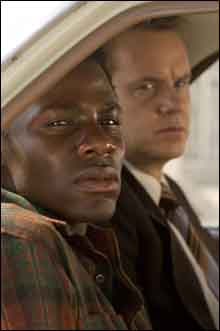
NOT JUST SINGING AND DANCING: The military wing of the African National Congress helped end apartheid. |
Even as Aussie Phillip Noyce built a lucrative career as a director of proficient 1990s Hollywood blockbusters (Patriot Games, Clear and Present Danger, etc.), fans of the distinguished films he’d made back home (Newsfront, Dead Calm) felt sold out. Eventually, Noyce himself became alienated from the commercial bent of his career, and in 2002 he made amends with two venerable political films, Rabbit-Proof Fence and The Quiet American. Catch a Fire is also a potent work of consciousness, and, like Rabbit-Proof Fence, a historical film about institutionalized racism, this time in 1980s South Africa.It’s from the true-life story of Patrick Chamusso (Derek Luke), a black foreman at a South African refinery. He turns radical freedom fighter after he and his wife are arrested, imprisoned for many days, and brutally interrogated because he is suspected of treason. There’s also a counter-story in which a rightist Afrikaner security officer (Tim Robbins) is obsessed that his family will be attacked by roving blacks.
Although Noyce manages a persuasive picture of South Africa in the last throes of apartheid, including some sterling battle scenes, Catch a Fire doesn’t have the impact of Rabbit-Proof Fence. Chamusso’s tale, as terrible as it is, doesn’t grab an audience as deeply and elementally as that of the two runaway Aboriginal girls. Still, anyone puzzling over how terrorists are made, not born, can learn a forceful lesson. And Noyce devotes a large chunk of his movie to something rarely treated in peacenik anti-apartheid film, the stirring, and startling, saga of the military wing of the African National Congress. Many viewers will learn for the first time that South African freedom came as much through warfare and violence as from singing and dancing.
“Digging in archival footage, I found that 40,000 blacks were training in Angola in 1981,” Noyce told me when we talked last month at the Toronto International Film Festival. “The threat they offered made the right wing within South Africa far more likely to acquiesce, to seek a peaceful resolution.”
He had some doubts about casting Derek (Antwone Fisher) Luke to portray Chamusso.
“I had it in the back of my mind that it’s a fool’s errand that a good old boy from New Jersey, a movie star, could connect with this South African experience. He’d never been to Africa before. I planned a boot camp for him to immerse him in contemporary South Africa, meeting many people there, hoping that, by osmosis, he’d become the character.
“I took him on a journey to meet the man himself, Patrick, and for three days they talked, and Patrick left his phone number. I’d look for Derek during rehearsals, he’d be in the corner of the set, telephoning. Two weeks before the shoot, Derek seemed burdened. I’d filled him up with too much. I’d failed.”
Then Noyce had the idea of taking Luke to Robben Island, where Nelson Mandela had been imprisoned for 27 years in a five-meter square cell. “We’d see if an epiphany was possible. Derek walked down to the famous cell, lay down on the floor, just stayed there for an hour. Pain passed through him, and the greatness of Mandela. And he channeled thousands of tortured souls. Derek was a new man when he left that prison.”
Luke was at last ready to shoot Catch a Fire. What about Noyce? “I deputized a platoon of black South African co-directors to work alongside me. Coming from Australia, I had a way to go myself — even farther than Derek!”